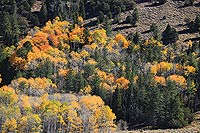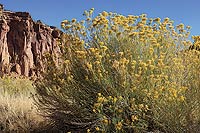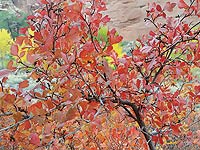 November in Canyon Country is represented by a mosaic of color. The rich hues of the local geologic layers seem to pop out as the sun moves farther south, bathing the cliffs in golden light. Gone is the mid-day glare of summer and in addition to the rocks, the vegetation adds splashes of colorful shades as the leaf pigments begin their autumnal transition.
November in Canyon Country is represented by a mosaic of color. The rich hues of the local geologic layers seem to pop out as the sun moves farther south, bathing the cliffs in golden light. Gone is the mid-day glare of summer and in addition to the rocks, the vegetation adds splashes of colorful shades as the leaf pigments begin their autumnal transition.
Starting high in the mountains, the fall of autumn begins with the quakies, Populus tremuloides, as the leaves lose their verdant chlorophyll pigments due to shorter daylight hours and cooler temperatures. As these pigments break down, they unmask other ones, called carotenoids and anthocyanins, which create the colorful yellows and golds and eventually the reds reminiscent of an eastern deciduous forest in the fall.
In contrast, the evergreens including ponderosa pine, Engelmann spruce, subalpine fir, and others are oblivious to the change. These trees are “ever green,” even though they too shed their needles, just not in the same manner as their deciduous neighbors.
 Following the aspen’s lead, shrubs such as Woods’ rose, Utah serviceberry, single-leaf ash, three-lobed sumac or skunk bush, and the Gambel’s oak, also follow this colorful transition.
Following the aspen’s lead, shrubs such as Woods’ rose, Utah serviceberry, single-leaf ash, three-lobed sumac or skunk bush, and the Gambel’s oak, also follow this colorful transition.
The oak groves skirt the mountains and are named for young American naturalist William Gambel (1823-1849) who tragically passed away at age 26 after an ill-fated overland trip to California. Leaving his group behind, Gambel and a few members of the group pushed on through early Sierra snows to a gold mining camp on the Yuba River. Many of the miners were sick with typhoid fever, and though Gambel treated many with his medical knowledge, he himself became sick and died.
An accomplished botanist and ornithologist at a young age, Gambel first joined a trading caravan in 1841, the Workman and Rowland Expedition, and traveled from Santa Fe to California on the Old Spanish Trail. Though it is unclear if Gambel passed through Moab, it would add an interesting connection to the area for this young man who eventually had several species named in his honor: the Gambel’s oak (Quercus gambelii), Gambel’s quail and the mountain chickadee (Parus gambeli).
 The oaks bare another connection to late fall: their acorns are food for black bears, small mammals, jays, and wild turkeys. During “mast” years when the nut crop is bountiful, the wildlife gorge themselves or, in the case of the jays, spend their days ferrying nuts to cache sites hidden throughout the forest. But it’s flocks of wild turkeys that patrol the forest floor picking up the nuts and grinding them in their powerful gizzards that is a sight to see. The wary birds seem to disappear into the trees when danger approaches but their repertoire of sounds keeps them in constant contact.
The oaks bare another connection to late fall: their acorns are food for black bears, small mammals, jays, and wild turkeys. During “mast” years when the nut crop is bountiful, the wildlife gorge themselves or, in the case of the jays, spend their days ferrying nuts to cache sites hidden throughout the forest. But it’s flocks of wild turkeys that patrol the forest floor picking up the nuts and grinding them in their powerful gizzards that is a sight to see. The wary birds seem to disappear into the trees when danger approaches but their repertoire of sounds keeps them in constant contact.
Moving down the mountain into the canyons and valleys, the procession of color continues as the season progresses. Along the riverways or lining the canyon bottoms, the willows, New Mexico privet, cottonwoods, and even the tamarisk, turn a golden contrast to the redrock. The privet, willows, and tamarisk take a back seat to the cottonwoods which can create a golden banner that seems to slice along the streambank. These cottonwoods hold their color well until the nips of autumn frost send a flurry of leaves fluttering to the ground. It is at this moment, the reality of fall settling in for a wintery nap really takes notice.